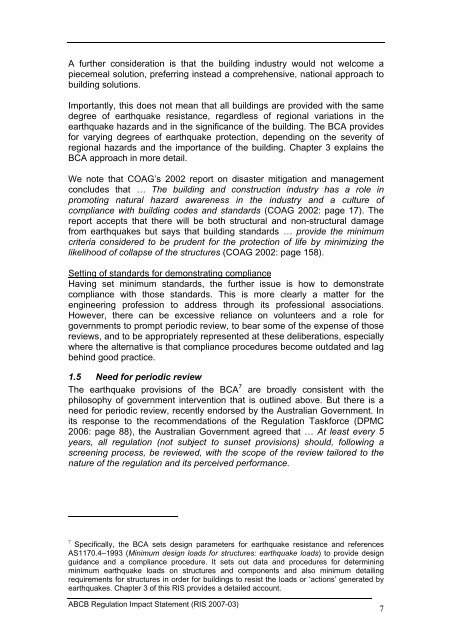PDF | 2 MB - Australian Building Codes Board
PDF | 2 MB - Australian Building Codes Board
PDF | 2 MB - Australian Building Codes Board
Create successful ePaper yourself
Turn your PDF publications into a flip-book with our unique Google optimized e-Paper software.
A further consideration is that the building industry would not welcome a<br />
piecemeal solution, preferring instead a comprehensive, national approach to<br />
building solutions.<br />
Importantly, this does not mean that all buildings are provided with the same<br />
degree of earthquake resistance, regardless of regional variations in the<br />
earthquake hazards and in the significance of the building. The BCA provides<br />
for varying degrees of earthquake protection, depending on the severity of<br />
regional hazards and the importance of the building. Chapter 3 explains the<br />
BCA approach in more detail.<br />
We note that COAG’s 2002 report on disaster mitigation and management<br />
concludes that … The building and construction industry has a role in<br />
promoting natural hazard awareness in the industry and a culture of<br />
compliance with building codes and standards (COAG 2002: page 17). The<br />
report accepts that there will be both structural and non-structural damage<br />
from earthquakes but says that building standards … provide the minimum<br />
criteria considered to be prudent for the protection of life by minimizing the<br />
likelihood of collapse of the structures (COAG 2002: page 158).<br />
Setting of standards for demonstrating compliance<br />
Having set minimum standards, the further issue is how to demonstrate<br />
compliance with those standards. This is more clearly a matter for the<br />
engineering profession to address through its professional associations.<br />
However, there can be excessive reliance on volunteers and a role for<br />
governments to prompt periodic review, to bear some of the expense of those<br />
reviews, and to be appropriately represented at these deliberations, especially<br />
where the alternative is that compliance procedures become outdated and lag<br />
behind good practice.<br />
1.5 Need for periodic review<br />
The earthquake provisions of the BCA 7 are broadly consistent with the<br />
philosophy of government intervention that is outlined above. But there is a<br />
need for periodic review, recently endorsed by the <strong>Australian</strong> Government. In<br />
its response to the recommendations of the Regulation Taskforce (DPMC<br />
2006: page 88), the <strong>Australian</strong> Government agreed that … At least every 5<br />
years, all regulation (not subject to sunset provisions) should, following a<br />
screening process, be reviewed, with the scope of the review tailored to the<br />
nature of the regulation and its perceived performance.<br />
7<br />
Specifically, the BCA sets design parameters for earthquake resistance and references<br />
AS1170.4–1993 (Minimum design loads for structures: earthquake loads) to provide design<br />
guidance and a compliance procedure. It sets out data and procedures for determining<br />
minimum earthquake loads on structures and components and also minimum detailing<br />
requirements for structures in order for buildings to resist the loads or ‘actions’ generated by<br />
earthquakes. Chapter 3 of this RIS provides a detailed account.<br />
ABCB Regulation Impact Statement (RIS 2007-03)<br />
7
















